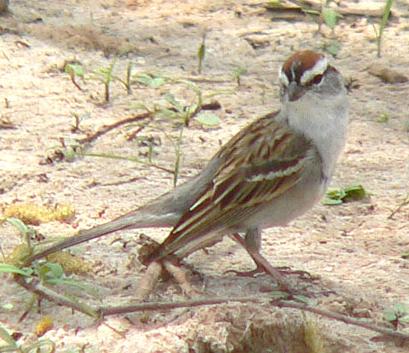Sparrow - Chipping
Chipping Sparrow Scientific Name: Spizella passerina
Sat, 12th July, 2025 - 3:50 am GMT
Sponsor Ads:

Alternative Name
Chipping Sparrow Scientific Name: Spizella passerinaBasic Info
The Chipping Sparrow has a brown top, streaked heavily with black. Their sides and underbelly are a light gray, with white eyebrows and a black line striking right through the eye. They also have a chestnut-colored crown.
Health
The Chipping Sparrow should be easily lured to your backyard, with the help of a seed feeder and a generous helping of bugs. They will also enjoy a fresh, clear birdbath, and will flock to backyards that have both a birdbath and a suitable place to nest. Breeding The breeding season for the Chipping Sparrow begins in April and goes until around mid-August. They will breed most anywhere in residential areas that are open and grassy, with a few trees. The female will lay a small clutch of about four eggs which will take a solid 11-14 days to properly incubate. The young birds will fledge about 10 days after hatching, and the parents will follow and nurture the young several days after they leave the nest, making sure they can properly survive on their own.Habitat
N/ABehavior
A friendly bird, but a solitary one, the Chipping Sparrow is a favorite among avid bird watchers. The Chipping Sparrow can be a little skittish among other birds. If you have feeders out, it will usually take the one furthest from your house, preferring to stay away from the company of the other birds. Other than that, this little wild bird is a fairly common species in the United States with a fairly common behavioral pattern. They are found all over the United States, in residential and wooded areas. They'll also eat arachnids. Only a few populations of the Chipping Sparrow migrate, and when they do, they head straight south, preferring the warmer climes of Mexico and South America to the frigid winters of the Northern United States. Their call is a single trill; if you don't know your birdcalls, they can be easily mistaken for other species with similar calls. They like nesting in conifer trees, although they've been found living in outdoor ornamental plants put out by homeowners. They will also nest in grassy areas, such as golf courses; especially open grassy areas with scattered trees. They build their nests from grass, small roots, and other plants, and then they line it with hair. They have also been known to try and nest in ornamental plantings, such as houseplants, and decorative trees, making them a familiar bird to human establishments.Origin
North AmericaHistory
Native to most of North America, the Chipping Sparrow will winter in the more southerly regions.Common Foods
They feed mostly on insects, although they'll forage heavily in lower areas of vegetation and sometimes on the ground, taking any seeds they find.Sponsor Ads:
"The general, unable to control his irritation, will launch his men to the assault like swarming ants, with the result that one-third of his men are slain, while the town still remains untaken. Such are the disastrous effects of a siege." -- Sun Tzu, The Art of War
Sparrow - Chipping
Coded by: BGID® | ALL RIGHTS RESERVED Copyright © 2000-2025
Disclaimer | Privacy | Report Errors / Contact | Credits








 President of the United States of America - Real Estate mogul, Pageant owner and now one of the most controversial men in political history.
President of the United States of America - Real Estate mogul, Pageant owner and now one of the most controversial men in political history.  Global warming has been in and out as the "latest" hot topic for many years. It is, according to modern scientists, the result of man-made industrial pollutants, clearing forested areas, agriculture, etc. But now they are thinking it started way before the Industrial Revolution...
Global warming has been in and out as the "latest" hot topic for many years. It is, according to modern scientists, the result of man-made industrial pollutants, clearing forested areas, agriculture, etc. But now they are thinking it started way before the Industrial Revolution...  Politician, US Vice President and President of the USA - Joseph Robinette Biden Jr.
Politician, US Vice President and President of the USA - Joseph Robinette Biden Jr.  versus
versus  Russia: 'The Evil Empire'? Are they all that bad or is it just the USA trying to portray Russia as bad because they are a world power with land bigger and a society very different from the USA ideal?
Russia: 'The Evil Empire'? Are they all that bad or is it just the USA trying to portray Russia as bad because they are a world power with land bigger and a society very different from the USA ideal? 
 Corona virus
Corona virus 
 Users with wide screen monitors can benefit from more content on every page.
Users with wide screen monitors can benefit from more content on every page.